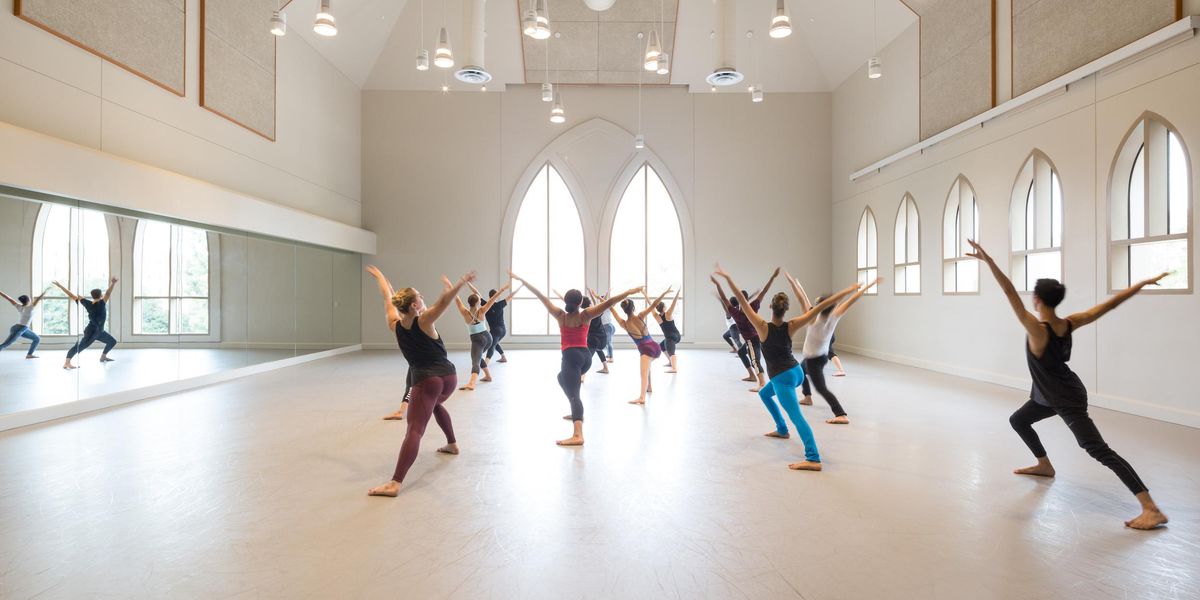2014 Summer Study Guide: A Week in Vienna
Inside David Zambrano’s ImPulsTanz workshop
I stood in a circle with 33 strangers, anxiously awaiting my turn. A propulsive playlist—track after track of funk, house, tango, hip-hop, soul—blasted through the cavernous studio. The game was simple: Two dancers entered the circle and improvised until the next two spontaneously entered. My turn would come whenever I made eye contact with a fellow student; we’d dance our way into the middle and create a duet on the spot.
If you don’t have a ton of improvisation experience, this can be an intimidating exercise. But I hadn’t traveled all the way to Austria to surround myself with safe, familiar situations. The nervous rush I felt upon finally entering the circle, finding my way moment by moment: That’s why I was here.
The game was part of “Improvisation for Performers,” a workshop taught by David Zambrano at ImPulsTanz, where, for one week last summer, I was a participant. Founded 30 years ago by arts producer Karl Regensburger and Brazilian choreographer Ismael Ivo, the month-long dance extravaganza is known for its rigorous workshops—in everything from Limón technique to voguing—as well as its progressive performances, an integral part of Vienna’s vibrant summer nightlife. The student body is breathtakingly international; within just a couple of days, I had met dancers from Poland, India, Norway, Spain and Brazil. Whether you stay for the full month or just a week (tuition runs roughly EUR 130–145 per workshop; scholarships are available), the festival can keep your body and mind engaged at all hours of the day.
As a New Yorker who takes class with just a couple of trusted teachers, I jumped at the chance to study with the festival’s international faculty, many of whom are known throughout the world but rarely teach in the U.S. In addition to class with Zambrano, who is based in Amsterdam, I signed up for “Body Reflection/Many States of Being” with the Québécois choreographer Benoît Lachambre and “Foundations of House” with the Haitian-born, Brooklyn-raised house dance veteran Brahms “Bravo” LaFortune. (Bravo teaches regularly in Manhattan, but I couldn’t resist.) All told, I was in for seven daily hours of dancing.
Above: Brussels and New Zealand-based Susanne Bentley leads a contemporary class.
Finding the workshops on the first day was a challenge in itself. ImPulsTanz’s enormous studios are housed in one of 25 imposing buildings at the Arsenal, a sprawling nineteenth-century military complex. After a few wrong turns, I made it to my morning class with Lachambre. A kind of open-ended kinesthetic meditation, the class began most days on the floor, with all 30-or-so students lying on mats. A wiry, guru-like figure, his long gray hair pulled back into a bun, Lachambre offered up images like “shining sit bones,” “sacrum like fins of a ray fish,” “lizard self” and “double helixes around the femurs” to help us tap deep, subtle layers of physicality, as we incrementally found our way to a standing improvisation. “Good warm-up for the day. Felt heavy, grounded,” I wrote in my notebook after the first class.
Without Lachambre’s gentle introduction to standing on two feet, I might not have felt prepared for the organized madness that was Improvisation for Performers. Of the three classes, this one pushed me most beyond what I thought I could do. It required an immediate, unwavering trust of others and oneself, a willingness to go to crazy, quirky, ugly places.
A sparkplug of a teacher (and a renowned performer himself), Zambrano substituted the term “improvisation” with “spontaneous choreography” to get us thinking compositionally about improvising—the shifts in dynamic, speed, mood, structure that make an improviser worth watching. We explored those concepts in pairs, small groups and as an entire class, following his spare yet pointed instructions for each exercise: Keep your eyes closed and feet planted in one position; or, think about opposing forces, like gathering and sending, arriving and departing, heaven and hell; or, do something you are really good at and something you know you can’t do. Zambrano had no trouble singling people out to make a point. “What does hell look like?” he asked us one day and called on student after student to demonstrate. From those whose first attempts were too meek, he demanded more: “Another hell, another hell,” he barked, until the student arrived at something more authentically hellish.
Above: A workshop in the style of Belgian company, Ultima Vez, taught by Laura Ar
ís Alvarez.
The mood was lighter over in “Foundations of House.” At the beginning of the week, Bravo, a towering man with a tough-love approach to teaching, told us that bringing house dance into the classroom was like caging a wild animal in the zoo: “You have to create the right environment,” he said. For house, which evolved in the clubs of Chicago and New York in the 1980s, that meant simulating, as much as possible, a wild dance party, which involves its own kind of improvisation. Sometimes Bravo, not unlike Zambrano, would ask us to circle up and ad-lib in front of the group, using what we’d learned that day. By the end of the week, I had no reservations at all.
Rent a Bike
. Biking is one of the best ways to get around Vienna. ImPulsTanz rents out its signature pink and blue bikes, emblazoned with the festival logo. (EUR 7 per day.)
Bring Your Lunch.
ImPulsTanz has an outdoor café with fresh, delicious food, but if you’re on a tight budget, buy groceries and pack your own lunch.
Give Yourself a Break
. As exhausting as ImPulsTanz can be, its outdoor amenities—a wading pool, wooden benches decked out in colorful cushions—give you space to relax after class.
Go All the Way.
For serious students looking for professional development, the DanceWEB scholarship program gives you the most in-depth ImPulsTanz experience. Learn more about it and the 2014 festival at impulstanz.org.
Photos by Karolina Miernik, Courtesy ImPulsTanz.




